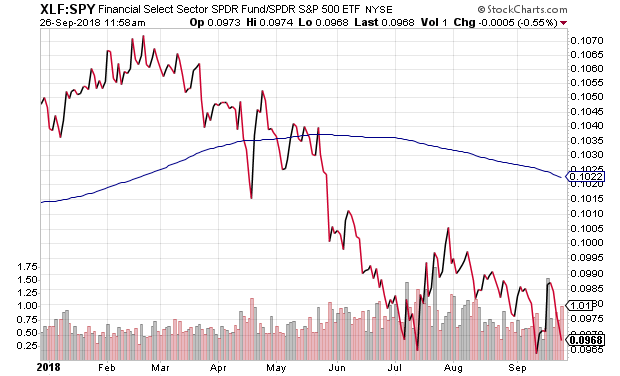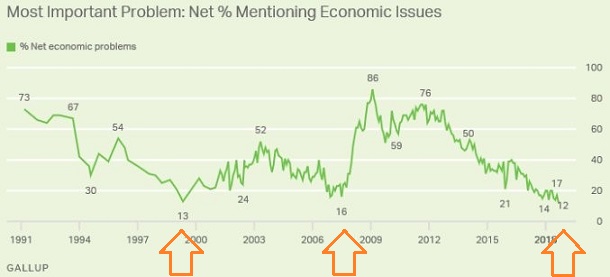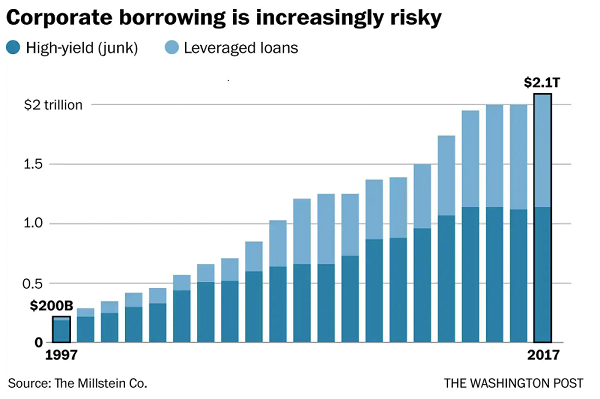The broader U.S. market has finally recovered from its late January meltdown. Indeed, most sectors have gone on to reach all-time highs.
On the flip side, a number of influential segments and sub-segments are still laboring. For instance, the Financial Select Sector SPDR (NYSE:XLF) remains roughly 5% below its January peak.
Theoretically, financial stocks should benefit from a rising interest rate environment. A healthy economy typically implies that borrowers have the capacity to repay. Moreover, with a strong economic backdrop, banks often have less balance sheet exposure to bad debts.
Unfortunately for investors in financial stocks, theory and reality have been diverging. The weakness in financials is readily apparent in the Financial Select Sector SPDR (XLF): SPDR S&P 500 (NYSE:SPY) price ratio.

What accounts for financial stock underperformance? Investors may fear the possibility of a credit calamity.
Consider previous credit cycle busts. There was the Savings & Loan Crisis in 1990, the Asia Currency Crisis in 1998, the subprime catastrophe in 2008 as well as the euro-zone sovereign debt collapse in 2011.
Each required central bank bailouts with varying degrees of “success.” Each had been accompanied by bearish price depreciation ranging from 19% to 50%.
There may not be a definitive sign of a financial crack-up on the horizon. Nevertheless, the inability of the iShares Global Financial ETF (NYSE:IXG) to restore early year glory suggests that investor trepidation may be building.

Keep in mind, the world has added something in the realm of $45 trillion in new debt since 2008’s financial upheaval. Most of that new debt will need to be rolled over and effectively refinanced at higher interest rates. Financial firms and pension funds will be increasingly exposed to borrowers on the brink.
U.S. market investors (ex financials) may be saying that domestic debt and deficits do not matter. At least today. At least right now. Still, the extraordinary disparity between foreign stock and U.S. stock valuations likely reflects anxiety about emerging market borrowing as well as euro-zone financial exposure to risky debts.

There is quite a bit of irony in our collective willingness to pay so much more for U.S. equities than foreign equities. Tremendous economic growth rates for emerging markets in the previous decade “justified” the breathtaking outperformance by Brazil, Russia, India and China (BRIC) over the U.S. By 2007, investors were willing to pay record valuations for foreign stocks.
In the current decade, however, the pace of economic growth has not mattered at all. Emerging markets have experienced far quicker economic growth rates in the 2010s than the U.S. Yet U.S. stocks have commanded an ever-expanding premium.
What justifies today’s U.S. stock premium over international alternatives? The front-loaded influence of tax reform for one. Whereas monetary stimulus is being chipped away at, corporations have funneled gobs of their corporate tax cut windfalls into stock buybacks.

Even as the Fed pivots away from easy credit, borrowing terms and borrowing access remain relatively loose. The Fed Funds range (2.0%-2.25%) is still negative when adjusted for inflation.
Another way to look at it? Prior to the financial collapse in 2008, had anyone told you that the Fed Funds Rate sat at 2%, you’d have assumed that we were smack in the middle of a recession. Instead, we have been witnessing remarkably high levels of consumer and business confidence as well as phenomenally low headline unemployment (U-2) in the tenth year of an economic recovery.
As accommodating on the monetary and fiscal policy fronts as things may be, as upbeat as current economic well-being appears, “peak everything” has rarely been a positive in the past. The last time that consumers were this optimistic, tech stocks tanked (2000) and layoffs led to recession (2001).

Gallup also offers up a poll that tracks the net percentage of people who regard the economy as the “most important problem” in the country. The net percentage is lower than it was prior to the 2000 tech wreck and the 2008 financial collapse.

Many who have studied monetary policy believe that the Federal Reserve was largely responsible for fueling the dot-com boom-bust cycle as well as the real estate boom-bust cycle. And there’s little debate about the Fed’s role in pumping up stock and real estate assets this decade. Indeed, it has been a record boom.
At this juncture, though, the Fed appears determined to raise overnight lending rates four times in 2018. The central bank is also moving forward at its fastest pace on balance sheet reduction to date.
So the questions become, “Is the Fed sowing the seeds for an epic credit cycle bust in the year or years ahead?” Conversely, “Can the Federal Reserve achieve a rare, but altogether desirable, soft landing?”
In my estimation, the Fed, alongside the rest of the world’s central banks, have already erred. “Too low for too long” rate policies since 2008 have led to a 75% increase in total global debt for households, corporations and sovereigns. Scores of “zombie” corporations will eventually default. Worse, the virus will spread.
Meanwhile, sovereign nations that binged will find themselves restructuring, defaulting or receiving bailouts. Contagion will likely occur whether or not policymakers are on the case.
Ironically enough, financial commentators like myself are not the only people raising concerns. In a recent report by the Federal Reserve:
“Rising risks are notable in the corporate sector, where low spreads and loosening credit terms are mirrored by rising indebtedness among corporations that could be vulnerable to downgrades.”
You think?

When the credit cycle turns, stocks are likely to go south. Fast.
Investors who banked on never-say-die asset inflation will be questioning a hold-n-hope strategy. Eventually, they’ll sell. Just like they did in the 2000-2002 dot-com disaster. Just like they did in the 2008-09 subprime mess.
One approach for avoiding a similar fate? Be a bit more conservative with your stock and bond allocation. Emphasize balance sheet strength in the equity component and emphasize credit quality in the income component.
Moreover, if you do not have cash equivalents in your mix, raise some cash. Most of my clients have 20% in a combination of money market funds and ultra-short term cash assets like JP Morgan Ultra Short Term (NYSE:JPST), PIMCO Enhanced Short Maturity (NYSE:MINT), Invesco Ultra-Short Duration (NYSE:GSY) or iShares Short Maturity (NYSE:NEAR).
Cash equivalents reduce portfolio volatility; they help you sleep better at night. What’s more, with these short-term funds yielding roughly 2.5%, the S&P 500’s 1.8% dividend yield becomes less attractive. Most importantly, having cash on hand is the primary means by which an investor can take advantage of deep discounts down the road.
Disclosure Statement: ETF Expert is a web log (“blog”) that makes the world of ETFs easier to understand. Gary Gordon, MS, CFP is the president of Pacific Park Financial, Inc., a Registered Investment Adviser with the SEC. Gary Gordon, Pacific Park Financial, Inc., and/or its clients may hold positions in the ETFs, mutual funds, and/or any investment asset mentioned above. The commentary does not constitute individualized investment advice. The opinions offered herein are not personalized recommendations to buy, sell or hold securities. At times, issuers of exchange-traded products compensate Pacific Park Financial, Inc. or its subsidiaries for advertising at the ETF Expert website. ETF Expert content is created independently of any advertising relationship.
